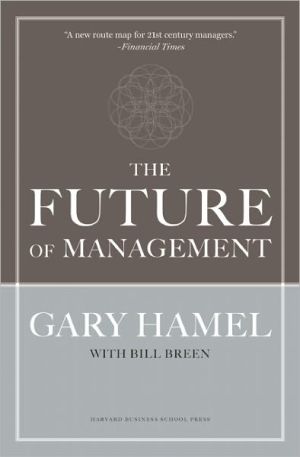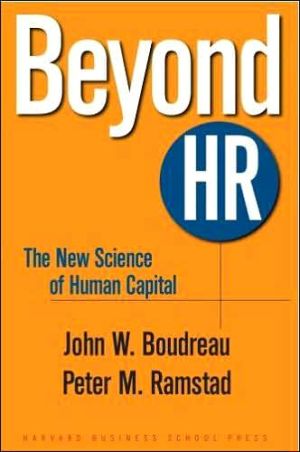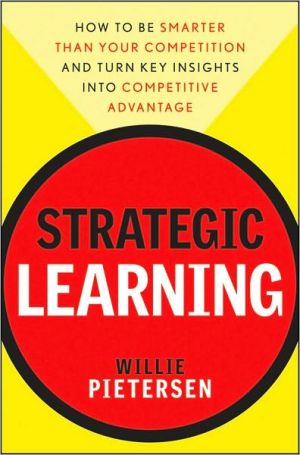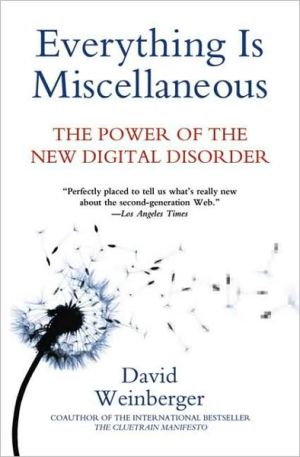Gadgets, Games and Gizmos for Learning: Tools and Techniques for Transferring Know-How from Boomers to Gamers
Praise for Gadgets, Games, and Gizmos for Learning\ "The big contribution of Gadgets, Games, and Gizmos for Learning to the field is that it provides direct linkages between the brain drain of the onrushing boomer retirement and the range of technologies, tools, and methodologies required to combat it."\ —Mark Oehlert, learning strategy architect, Booz Allen Hamilton\ "Kapp does an excellent job describing the neo-millennial student and the ways new and emerging web-tools, video games,...
Search in google:
As the members of the baby boomer generation retire, scientists, CEOs, nuclear technicians, doctors, senior trainers, and other highly skilled individuals are taking with them all of their expertise. Simultaneously, a new generation of employee (dubbed "gamers") is entering the workforce with a different focus and learning style. For the first time, our workplace will experience the invasive influence of video games, Internet surfing, blogging, and podcasting. Gadgets, Games, and Gizmos for Learning is an innovative book that provides practical and original solutions to the impending boomer/gamer knowledge and skills transfer gap. The book outlines how gamer values such as the use of cheat codes, the love of gadgets, the need to play games, and the desire to be constantly connected can be used as methods for moving information from the heads of the boomers to the fingertips and gadgets of the gamers. As organizations begin to think strategically about how to attract, retain, and train new talent, this book will be an invaluable resource. Author Karl Kapp includes a list of techniques for re-casting existing training and computer systems into tools that will bridge the gap between the boomers and the gamers. The book reveals the new methods that are being used successfully in a variety of settings such as the entertainment, game, and electronics industries. Gadgets, Games, and Gizmos for Learning offers valuable new information on the use of atypical learning and performance support methods such as the use of Flash mobs and cheat codes, video iPods, and even instant messaging and blogging. The book debunks the notion that the "toys" and "bad habits" of gamers have a negative impact on the workplace. Instead, the book describes how these items can actually be used to achieve an advantage by savvy, innovative organizations. The book also shows how to sell these "radical" concepts to upper management and executives who are typically boomers with a completely different perspective than gamers.
Gadgets, Games and Gizmos for Learning\ Tools and Techniques for Transferring Know-How from Boomers to Gamers \ \ By Karl M. Kapp \ John Wiley & Sons\ Copyright © 2007 John Wiley & Sons, Ltd\ All right reserved.\ ISBN: 978-0-7879-8654-4 \ \ \ Chapter One\ Crossing the Chasm\ Sitting alone in a dark and dreary basement is a male creature bathed in a flickering bright light. Occasionally this strange beast emits a sound of defeat, screeching as if its life were ending. At other times, the creature lets out a cry of sheer joy, leaping up and down as if it had just conquered the world.\ This is the somewhat skewed image most baby boomers (or boomers) have of someone who plays a lot of video games (Figure 1.1). It is the image of a lonely teenage boy sitting in his parents' basement hours on end and socializing with a game. He thrives on playing in an environment of extreme violence and debauchery. Parents, teachers, and other concerned citizens often mumble or even yell, "Video games rot brains! You'll never grow up to be any- thing if you play video games all day."\ Nothing could be further from the truth. A growing body of research has begun to reveal that video and computer games have tremendous educational value. It turns out that many of the traits, habits, beliefs, and actions that teenagers and young adults pick up playing electronic games and workingwith handheld gadgets will help them as they enter the ever-changing global workforce.\ In fact, these very traits will forever alter the makeup of businesses, educational institutions, and government agencies. Boomers will be forced to adjust to the characteristics of the gamers, and gamers will need to learn the rules of the boomers. As this generational transition occurs, it is fraught with the usual strife between the work ethic and beliefs of the incoming generation and the institutions and parameters of the ruling generation.\ And the timing couldn't be worse.\ As gamers enter the workforce, boomers are leaving in droves and taking with them decades of knowledge, experience, and know-how. These independent, career-driven boomers have collectively transformed economies and driven productivity to unprecedented levels. They have lived through and shaped one of the most prosperous and dangerous times in history, and now they are leaving.\ It is almost impossible to underestimate the knowledge gap that will be caused by the retirement of the boomers, a retirement wave that is already underway. In the next five years, approximately 40 percent of the skilled labor force will retire. In the next ten years, the entire boomer generation will be over fifty years old.\ As the boomers leave and gamers enter, there needs to be an unprecedented transfer of knowledge, information, and data from one generation to the other. The transfer needs to be smooth and effective, or corporations, academic institutions, and government agencies will experience tremendous setbacks in productivity, profitability, quality, and even safety.\ In his book Lost Knowledge, David DeLong tells a frightening story of a nuclear weapons designer retiring from the Los Alamos National Laboratory after thirty years of loyal service. Usually the retirement of one person is not that big of a deal. However, this retirement is of particular importance: the employee's exit leaves no one left in the lab who understands the design of missiles built between the 1950s and 1960s. "So what?" you might ask. "These missiles are no longer used, are they?" In fact, they are deployed in military bases all over the world. The weapon designer's knowledge of nuclear missiles has to be transferred accurately and effectively to the next generation. Lives are at risk.\ In a less dramatic example, one organization had to shut down its most successful production line for a month because a retiree left with key knowledge she didn't even know she possessed. She was the only one who knew the proper method of placing a circuit board onto a customized soldering bench. Although the company thought to give her a gold watch as she retired, no one thought about the need to train a replacement. It was a simple job, after all; the new employee would just follow the written standard operating procedure (SOP) for circuit board placement.\ Unfortunately, the SOP was wrong: the documentation had the placement of the board upside down. The retiree knew the SOP was wrong because she had discovered it years ago. And once she discovered the difference, she never used the SOP, and just placed the board in the correct position. She didn't even think about it. Her replacement followed the SOP to the letter, and millions of dollars of circuit boards had to be scrapped. The retired employee solved the problem when the company, four weeks later, decided to call her back to see if she could solve the problem. It took her ten minutes.\ Where Is Everybody Going?\ One of the biggest, most difficult issues facing organizations over the next ten years is knowledge transfer. In less hectic times, the knowledge transfer from the outgoing generation to the incoming generation took place slowly and at a pace easily digestible by organizations and institutions. This time the pace is blistering. Boomers are ready to retire now. Even if they don't fully retire from the workforce, they will be retiring from their current positions.\ Muddying the water is the fact that the incoming gamers have grown up in a vastly different world than the boomers did. Gamers have different ideas about connectivity, reporting hierarchies, learning, and communication, all forged while playing games, manipulating gadgets, and surfing the Web.\ Organizations that successfully transfer business acumen and hard-earned experiences to the incoming gamer generation will see tremendous leaps in productivity, quality, and profitability. Organizations that cannot transfer knowledge will experience dire results.\ Going, Going ...\ The numbers are staggering. There are between 64 and 77 million boomers, roughly 28 percent of the total U.S. population and 40 percent of the workforce. The sheer size of the post-World War II boomer generation has shaped everything it has encountered.\ In the 1950s and 1960s, when the number of children ages five to fourteen increased by more than 40 percent, the sales of potato chips skyrocketed. Auto sales rose as the boomers reached driving age. When the boomers move on, what they once embraced tends to languish like the Hula Hoop or the large number of primary schools built in the 1960s.\ Over the years, the boomers have "built up a tremendous amount of knowledge about how things work, how to get things done, and who to go to when problems arise. In some cases, this practical knowledge will be extremely hard to replace because it has been developed in an era of unprecedented technological and scientific advances." The knowledge is starting to walk out the door and will soon be sprinting toward the exits.\ The leading edge of the boomer generation began turning sixty in January 2006. According to the Bureau of Labor Statistics approximately 35 million boomers will retire between 2000 and 2020 and another 23 million will retire during the following ten years.\ Boomers are ready to retire for a number of reasons: changing interests, a desire to make a difference, spending more time with the family, playing more golf, and concerns about their health. Although boomers claim that they want to rewrite retirement rules and stay employed until later in their sixties, research indicates that most will call it quits earlier than they think. While nearly half of baby boomers expect to work past age sixty-five, only 13 percent of current retirees actually work until that age.\ Many retire because they see themselves as not healthy enough or feel too old to work. As of 2005, only 60 percent of sixty year olds, 32 percent of sixty-five year olds, and 19 percent of seventy year olds were employed. The average retirement age in the United States is fifty-nine. A survey of London accountants found that one in ten did not envision working past age fifty. There is a strong possibility that boomers will not work for as long as they are predicting (or hoping).\ Even if boomers do stay employed, chances are it will be in a new job. They will become independent consultants or switch to another line of work. Although 71 percent of workers ages forty-five to fifty-six plan to work into their retirement years, 35 percent of that group plan to work part time for interest or enjoyment, 11 percent expect to start their own business, and 7 percent plan to retire from their current jobs but work full time at something else. So even if boomers do not leave the workplace en masse, they will most likely be leaving your organization, taking with them a vast amount of knowledge and possibly costing your company dearly if you don't prepare now.\ Broad Impact. No segment of the economy will escape unscathed. The U.S. Defense Department's civilian workforce of 675,000 is expected to lose 506,250 people by 2010. One-third of all secondary schoolteachers in the United States are expected to retire by that time as well. The oil and gas industry can expect to lose more than 60 percent of its employees by 2010, as will the aviation industry.\ In the automobile manufacturing sector, the estimated cost of retiring boomers is between $50 and $100 million. This high cost reflects the expense of recruiting new employees, training those employees, and, most critical, lost productivity. The experienced boomers are taking a lot of know-how with them. According to Kim Hill of the Center for Automotive Research in Ann Arbor, Michigan, "The looming skilled labor shortage is the single most important issue the U.S. automobile industry will be facing in the next five to ten years."\ The manufacturing sector is in particularly bad shape; many manufacturing companies have eliminated their apprenticeship programs. Trade and vocational schools are mistakenly viewed as places to send troubled students. There have been well-publicized layoffs and plant closures. All of the signals are leading gamers to fear that manufacturing jobs are dead ends. The manufacturing industry will not be able to transfer knowledge to new employees if new employees don't enter into the field. In fact, many old-economy jobs are not seen as desirable by the gamer generation, and the recruitment of gamers is going to be a hot issue in those fields.\ While manufacturing seems to have it bad, other studies indicate it is not in the worst shape. Examine the energy, health care, and government sectors for the really alarming data. Half the U.S. government's civilian workforce is eligible to retire within four years. With these types of retirements, there could be a labor shortage of over 5 million skilled workers between 2010 and 2012, because only 25 percent of U.S. companies surveyed indicated they were ready for such a mass exodus. A staggering 31 percent indicated that they have not even thought about the problem.\ International Trend. The problem is not confined to the United States. In Europe, the pool of workers ages thirty-four to forty-four is expected to shrink by 19 percent in the United Kingdom, 27 percent in Germany, and 9 percent in Italy. The Ford Motor Company expects the number of workers older than fifty years old to double in its European plants by 2010. Across Europe, baby boomers are already starting to retire, although the first of the European boomers won't reach age sixty-five until 2011. Many of Europe's state-funded pension systems encourage early retirement. Currently, 85.5 percent of adults in France quit work by age sixty, and only 1.3 percent work beyond sixty-five. In Italy, 62 percent of adults call it quits by age fifty-five.\ In Japan, the number of people between ages fifteen and sixty-four is expected to decline an average of 740,000 a year for the next ten years; already seventeen out of every one hundred people are over age sixty-five, and this ratio will become thirty out of a hundred in fifteen years. Japan's large neighbor, China, will have over 265 million sixty-five year olds by 2020.\ Traits of Boomers\ The workplace the boomers are leaving behind is one of their own creation. Although boomers are retiring, they are still very much in control of many institutions, from for-profit companies, to academic institutions, to political leadership. The events and the social setting in which the boomers grew up influences how they act, interact, and react to social and professional situations. Boomers have been classified as having the following characteristics:\ Individualistic\ Driven\ Loyal\ Idealistic\ Skeptical\ Individualistic\ Boomers value independence and work hard to do their own thing. The skeptics call them the "Me" generation because of the intense focus boomers have on themselves and their own wants and needs. Boomers pioneered the concept of customized products and services. They stand in line waiting to order a grande double espresso with a shot of caramel syrup or one of the other staggering number of coffee options available at Starbucks. Boomers have driven food companies to offer more and more specialized items. Arby's sold only one kind of roast beef sandwich when it was founded in 1964. It now sells thirty different sandwiches. Dryer's Grand Ice Cream offered 34 flavors in 1977; now it offers over 250. The boomers want to do their own thing, even if it means scrapping some of the institutions of their parents. In fact, nearly 50 percent of all U.S. marriages now end in divorce partly as a result of the desire of boomers to "go their own way."\ Driven\ The drive of this generation is evident in their early commitment to social causes and their later commitment to work and fulfilling their own dreams. This generation invented the term workaholic. To boomers, work and life become intertwined in a drive for that elusive sense of success. They applaud the achievement of individuals and strive for the recognition and trappings that come from obtaining success. This generation created the concept of quality time, meaning that if you spend a little bit of high-value time with your kids, it is the equivalent of spending a lot of "regular" time with them. In this generation, both parents tend to work. Boomers take their intense drive and work ethic with them into profit-driven activities as well as leisurely pursuits.\ Loyal\ Boomers are loyal. Their loyalty to brand names like Coca-Cola, Harley Davidson, and Disney is legendary. Boomers have been known to tattoo logos of these brands on their bodies. They have intense loyalty to the past and to such rock groups as the Rolling Stones who have been touring for decades. Some pundits see this as a refusal to grow old, while others see the loyalty to corporations and to each other as a positive trait. They respect face-to-face meetings and build loyalty through physically meeting with others and establishing face time with peers. Boomers work well in a team setting controlled by an outside authority like a manager or a boss. They respect and are loyal to their work and social teams. They hang together in times of strife and pressure.\ Idealistic\ Although not every boomer was at Woodstock, lived in a commune, or participated in a college sit-in, they do generally have a tendency toward idealism and spirituality. They have a certain expectation of how society and organizations should function. This generation saw leaders like Martin Luther King Jr. make a difference and organizations like the Peace Corps come to life. They witnessed the United States putting a man on the moon. Boomers marched for civil rights and launched the feminist and gay rights movements. They believe in crusades, ideals, and working tirelessly to see those ideals come to fruition. The group Mothers Against Drunk Driving (MADD) was founded by a boomer in the 1980s.\ Skeptical\ But this generation also witnessed the shooting of President John F. Kennedy, the assassination of Martin Luther King Jr., and the shooting of Robert Kennedy on television. This is the same generation that followed the Grateful Dead, flaunted rock and roll in the face of their parents, shouted the phrase, "Don't trust anyone over thirty," protested every type of institution from universities to the government, and then graduated from college and went to work for J. P. Morgan, Arthur Andersen, and Coopers & Lybrand-some of the stodgiest institutions in the country.\ (Continues...)\ \ \ \ \ Excerpted from Gadgets, Games and Gizmos for Learning by Karl M. Kapp Copyright © 2007 by John Wiley & Sons, Ltd. Excerpted by permission.\ All rights reserved. No part of this excerpt may be reproduced or reprinted without permission in writing from the publisher.\ Excerpts are provided by Dial-A-Book Inc. solely for the personal use of visitors to this web site. \ \
List of Figures and Tables. Foreword, by John Beck. Preface. Acknowledgments. Chapter 1 Crossing the Chasm. Where Is Everybody Going? Traits of Boomers. Defining a Gamer: Four Levels. Traits of Gamers. The Chasm. Building the Bridge. What’s Coming in This Book. Chapter 2 It’s in the Game. Basic Types of Knowledge. Workplace Implications. Summary. Chapter 3 The Virtual Apprentice. Higher-Level Types of Knowledge. Workplace Implications. Summary. Chapter 4 Go, Go Gadget. Gadgets Allow Access. How Gadgets Will Be Used to Transfer Knowledge. Workplace Implications. Summary. Chapter 5 Cheaters Never Win . . . or Do They? To Use a Cheat Code or Not to Use a Cheat Code. Rules Were Made to Be Broken. Bending the Rules. Workplace Implications. Summary. Chapter 6 Searching for the Ideal Learning Event. Learning at Work. Embracing Informal Learning. Workplace Implications. Summary. Chapter 7 Replace Education with Automation. Innovation Trumps Education. Are We There Yet? Don’t Educate, Automate. Work Flow Learning. Workplace Implications. Summary. Chapter 8 Trust Me; You Don’t Want to Be the Boss. Warning: Gamer with Attitude Ahead. The Problem with Being the Boss. The Problem with Being the Teacher. Become a Strategy Guide. Create Self-Directed Teams. Workplace Implications. Summary. Chapter 9 And the Winner Is . . . . Recruiting Gamers. Workplace Implications. Summary. Chapter 10 Please, Please Can I Buy a Game, Gadget, or Gizmo? Tough Sell. Diffusion of Innovations. Workplace Implications. Summary. Chapter 11 Getting to the Next Level. Knowledge Requirements Planning. Workplace Implications. Summary. Chapter 12 It’s Not "Just a Game." It’s a Virtual Black Market. Making an Honest “Online” Living. Enter the Matrix. Crossing the Bridge. The Future. Epilogue. Notes. Index. About the Author.








